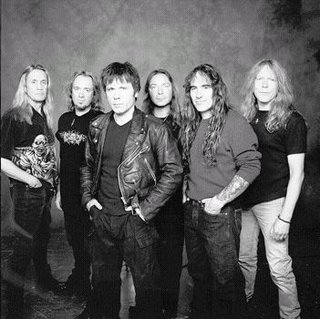 True story: I was driving around with the little dude in the car seat, listening to Iron Maiden’s Killers. The song that grabbed his attention was “Wrathchild,” which he thought was pronounced “rockchild” because he understood the track is pretty rockin’. So he’s doing the obligatory head-nodding, throwing up the horns like I taught him, and trying to get my attention in the rear view mirror buy saying “Look at me! I’m a wrathchild!” It was one of those bonding moments that make you think the kid will turn out all right.
True story: I was driving around with the little dude in the car seat, listening to Iron Maiden’s Killers. The song that grabbed his attention was “Wrathchild,” which he thought was pronounced “rockchild” because he understood the track is pretty rockin’. So he’s doing the obligatory head-nodding, throwing up the horns like I taught him, and trying to get my attention in the rear view mirror buy saying “Look at me! I’m a wrathchild!” It was one of those bonding moments that make you think the kid will turn out all right.Later on, we were watching “Full House” together (his choice, he has a thing for toddler-era Olsen twins) when John Stamos appeared in a scene. Stamos was dressed in black, had an electric guitar and that silly looking mane on his head, which prompted the little one to declare “He’s a rockchild too, Daddy.” I had to correct him, of course, because there’s a huge difference between Iron Maiden and John Stamos.
I’ll admit to not following Maiden too closely for quite some time; I lost track of them during my obligatory “purge everything metal” phase, which I’ve thankfully realized was a completely stupid thing on my part as I’ve come to terms with my metal influences. Maiden was one of them, of course, but by the time I reconciled with the genre, Maiden had replaced vocalist Bruce Dickenson and who wants that?
Two albums ago, the rest of the band brought Dickenson back and guitarist Adrian Smith, providing fans with a reunion of the classic Maiden line-up of the 80’s. But riding a wave of nostalgia is not the sort of thing that the band is apparently content on doing. Their latest release, A Matter Of Life And Death, finds the band forging ahead while keeping their enormous influence and bravado completely in tact. It’s reassuring that this, their fourteenth album, not only manages to complement their existing catalog but also add some range to it.
The opening track, “A Different World,” is a great example of this. Leading with that famous Maiden trademark sound, the song begins by focusing on those who are unwilling to change and unhappy that they can’t stop change from happening. The song then suddenly opens into a wonderful, lower register chorus, preaching tolerance (“tell me what you can hear/and then tell me what you see/everybody has a different way to view the world”) without the use of Dickenson’s famous operatic vocal scalings.
It’s also the shortest track, clocking in at a hair over four minutes. The rest of the album approaches epic qualities with three tracks going over the eight minute mark, four over seven, and the rest over five; like the Iron Maiden of old, there is a slim chance that any of the songs will be provided commercial exposure.
A Matter Of Life And Death feels like a looser effort than albums past. Drummer Nicko McBrain limits the fills and focuses more on playing in the pocket while the band’s three(!) guitar attack is clearly defined and fluid, including some acoustic flourishes that appear on a few of the songs. Surprisingly, the band seems to have made an album that was conceived, recorded, and released fairly quickly. This approach works for them; Maiden has been at this thing long enough that they can be tight without the help of studio gadgets and obsessive perfectionists manning the control room. I’m looking at you, Bob Rock.
There will be a few fans that miss the operatic bombast of Dickenson’s voice on every track, and they may be a little dismayed at a more progressive rock direction the band appears to be taking with this release. The reality is that Maiden have has some progressive tendencies in their leather armbands. Now they seem comfortable enough to demonstrate it rather than roll over them like they’ve already perfected.
A Matter Of Life And Death won’t be the album that gets you to suddenly appreciate Iron Maiden (you get them or you don’t) and it’s not the “return to form” album that existing fans probably want them to make. In their minds, they’ve made those records and you’re welcomed to pick them up (The Number Of The Beast, Piece Of Mind and Powerslave are where you should start) and watch them prove their worthiness in a live setting where, apparently, they still have the ability to rule. Instead, it’s a very credible example of a band that understands if they’re content with simply holding on to nostalgia, they’re as good as dead. Or Ed, as the case may be.
This review originally appeared in Glorious Noise
No comments:
Post a Comment